LC3bA3
Computers and Literacy in Traditional Languages
Robert W. Lawler in collaboration with Mamadou Niang and Moussa Gning [1]
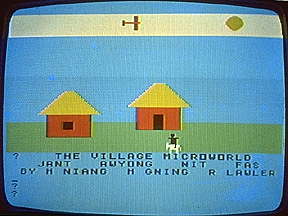
XEW, the “village” Wolof Language microworld.
Microcomputers are pouring into homes and schools in the industrialized
countries and will soon be flooding the world. It is hardly too soon to
wonder what effects computers are likely to have on our children. Will computers
change the way children learn? Will computers change the sorts of people
children become? I believe the answers may well be yes, and although it
is too early for conclusive proof, I can offer here a story that supports
my belief.
I have worked in the computer industry for sixteen years, and when my children
were born I became interested in the potential impact of early computer
experiences on children’s learning. Several years ago, in collaboration
with a computer language project at the Massachusetts Institute of Technology,
I began an intensive study of how daily access to a computer influenced
the way my two older children–then aged six and eight–learned the basics
of arithmetic. By the time their younger sister Peggy turned three, a microcomputer
had become standard equipment in our household, and I began to develop several
programs to give Peggy access to the machine. Playing with these programs
in her own way and on her own initiative over the following months, Peggy
began to do something that looks very much like the beginnings of reading
and writing.
What is it really like to bring a microcomputer in your home and let your
three-year-old play with it? The answer depends on who you are, your knowledge
and values. The computer entered my home and my family life because it is
a part of my work. It was my pleasure to write some simple programs for
my daughter’s entertainment and edification. My interests in children and
computers led me to gather a great deal of information about what Peggy
knew before her first encounter with the computer and afterwards. Between
her ages of three years three months and three years ten months, Peggy began
to read and write. The following sketch of how this happened is based on
my own observation of only one child’s learning; it is fair to say, however,
that I have an enormous amount of detailed information about what this particular
child knew and how that knowledge changed over a long period of time. I
believe this sketch will be of general interest because Peggy’s story provides
some advance information about how computer experience may affect our children.
In the USA children typically learn to read around the age of six. Most
learn to read at school. A few teach themselves to read earlier. Peggy,
at the age of three, even living in a bookish family, did not know how to
read in any substantial sense before her computer experience. Her knowledge
of letters at three years, three months was quite specific and limited.
She recognized only a few letters as distinct symbols with any meaning.
For example, she knew that "P" was the first letter of her name.
She also recognized "G" as the "mummy letter" because
her mother’s name is Gretchen.
What was Peggy’s knowledge of spelling like? One incident gave me some inkling.
My oldest daughter was learning a bit of French: one day Peggy claimed that
she knew how to "spell French" and continued, "un, deux,
trois, quatre, cinq. " At another time her spelling of "French"
was "woof boogle jig." Peggy saw the process of spelling as decomposing
a meaningful word into a string of essentially meaningless symbols and had
not yet learned any of the standard spellings of words.
Peggy’s ability and willingness to identify a string of symbols as a particular
word came from a very specific beginning. After receiving a gift book from
her older sister (who then wrote Peggy Lawler on the flyleaf), Peggy interpreted
all small clusters of alphabetic symbols as "Peggy Lawler. " At
a later point in time, as a consequence of being often read to, she became
able to recognize a single, two letter word, "by", which appeared
on the title page of every book we read to her. There is no reason to believe
she had any idea of what "by" might mean in that context. Her
knowledge of reading as a process for interpreting graphic material is best
seen in her common observation that she read Pictures and I read Words.
From her remark. we can infer she would expect to do the same with words.
Not a bad assumption, but completely empty of any information about how
written words signify as they do.
Contrast now her knowledge seven months later. Her knowledge of letters
is essentially complete, in that she discriminates the 26 letters of the
alphabet and can name them. Her knowledge of words, in the sense of interpreting
them one at a time, is significantly greater. She reads more than 20 words,
most with complete dependability. But unlike children who have learned to
read and write by conventional means, she sees the spelling of words as
stepwise directions for keying a name into the computer. Although her general
idea of what book reading is may not have changed, she has a different and
powerful idea of what reading single words means that derives directly from
her experience with my computer programs. Peggy’s introduction to computers
did not relate directly to "reading" in terms of content, but
her desire to control the machine led her into keying on the computer her
first "written" word. Having helped load programs by pushing buttons
on a cassette tape recorder, one day on her own Peggy typed "LO"
on the terminal then came seeking direction as to what letter came next.
A few days later, she typed the "load" command while the rest
of the family was busy elsewhere.
I call the computer environments created by the programs I have written
"microworlds", following the terminology used by Seymour Papert,
the man chiefly responsible for the development of the "LOGO"
computer language, in his book Mindstorms. The initial microworlds were one
for moving coloured blocks around on the video display screen and another
(made for her older sister but taken over by Peggy) which created designs
by moving a coloured cursor. While her sister used this drawing program
to make designs, Peggy’s first drawing was a large box–which she immediately
converted into a letter "P" by adding the stem. Letters intrigued Peggy.
They were a source of power she didn’t understand.
A few days later, Peggy keyed the letter "A" and explained to
me that "A is for apple. " Her comment suggested away we could–
on the computer–make a new kind of pre-readers’ ABC book. A child’s book of
ABC’s typically offers a collection of engaging pictures displayed in alphabetic
order with a large, printed letter associated with each picture. The child
looks at the pictures and is informed "A is for apple. " The relationship
of letters to pictures is exactly the opposite in the ABC microworld. The
letter is the "key" for accessing the picture. That is, keying
the letter "D" produces a picture of a dog. Instead of responding
to a statement such as "See the doggie. D is for dog, " Peggy
was able to try any letter on the keyboard, first, to see what it got her,
and later, if the picture interested her, to inquire what was the letter’s
name. She was in control of her own learning. She could learn WHAT she wanted,
WHEN she wanted to, and could ask for advice or information when SHE decided
she WANTED it. The ABC microworld was tailor-made for Peggy. The shapes
were selected and created on the computer by Peggy’s older sister and brother,
aged ten and twelve. As a consequence of playing with the ABC microworld–and
with another to which we now turn–Peggy developed a stable and congenial
familiarity with the letters of the alphabet.
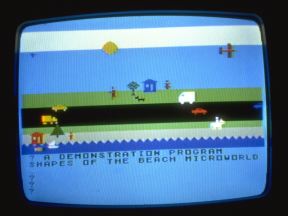
A Demonstration scene of the BEACH microworld
More complex and interesting than the ABC microworld, the BEACH microworld
provides a backdrop for action. Waves and a beach in the foreground, with
grass above, rise to a road, more grass, and clouds at the top. Against
that backdrop, Peggy could create a small picture of an object by specifying
a procedure name, then manipulate the picture with commanding procedures.
Peggy typically began constructing a scene with the word SUN. A yellow circle
would appear in the waves. She would raise it to the sky by keying the word
UP repeatedly, change its colour or set it in motion with another word,
and go on to other objects. She could, for example, make a CAR image appear
by keying that word, change its location with commands UP, DOWN, MOVE, and
specify its heading and velocity with TURN, SLOW, FAST, FASTER, and HALT.
These microworlds were created using Logo, an easily comprehensible computer
language which permits you to assign meaning to any string of letters by
writing simple procedures. Logo’s procedure definition was especially valuable
in customizing the BEACH world. When Peggy first used BEACH, she was unhappy
with the speed of the objects and asked, "How can I make them zoom,
Daddy?" Nothing was easier than to create a new Logo word, ZOOM, which
set the velocity of the object with a single primitive command. In a further
instance, Peggy’s older sister made a horse-and-rider design and wrote a
PONY procedure to create an object with a horse-and-rider design and set
it in motion. After watching her sister edit that shape design, Peggy imitated
the specific commands to create her own new shape. (She could not well control
the design and ended with a collection of perpendicular lines. Asked what
it was, she first replied "A pony, "then later, "Something
important. ") It is very likely that primary grade children could create
their own designs and would copy and alter procedures to expand or personalize
the vocabulary of BEACH-like microworlds.
As a direct consequence of playing with the BEACH world, Peggy learned to
"read" approximately twenty words. Initially, she keyed names
and commands, copying them letter by letter from a set of cards. Soon, her
favourite words were keyed from memory. Less familiar words she could locate
by searching through the pile of cards. When her mood was exploratory, she
would try unfamiliar words if she encountered them by chance. Now, when
shown those words–on the original cards or printed otherwheres–she recognizes
the pattern of letters and associates it with the appropriate vocal expression.
Further, the words are meaningful to her. She knows what they represent,
either objects or actions.
In the past, words for reading have always been an alphabetic symbol for
an idea to be evoked in the mind. For Peggy, words are that but something
else as well–a set of directions for specifying how to key a computer command.
What is strikingly different in this new word-concept, as contrasted with
quasi-phonetic decoding, is that the child and computer together decode
a letter string from a printed word to a procedure which the computer executes
and whose significance the child can appreciate. Finally, because the computer
can interpret specific words the child does not yet know, she can learn
from the computer through her self directed explorations and experiments.
What might the words of this world mean ?>br>
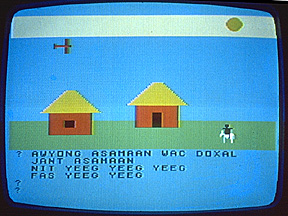
XEW, the “village” Wolof Language microworld.
The basic lesson I draw from this story is NOT merely about "motivation"–although
Peggy did enjoy playing with these microworlds and learned from doing so.
There is a more revolutionary aspect, one paradoxical as well. This new
technology can make possible a more "natural" absorption of knowledge.
The character of words experienced as executable procedure names brought
Peggy into a new relationship with language, one different from what has
been characteristic of learning to read in the past.
Learning to read from print is necessarily a passive process for the child.
Words on the page stand for other people’s meanings. Until children start
to write, they can’t use written words for their own purposes. Microcomputers
put reading and writing together from the start. A word that Peggy can read
is also one she can use to produce on the computer effects that interest
her. For Peggy, learning the alphabetic language has become more like every
infant’s learning of the vocal language. Speaking is powerful for the infant,
even for one who commands but a few words, when a responsive person listens.
Likewise, the production of alphabetic symbols–even one letter and one
word at a time–can become powerful for the young child when computer microworlds
provide a patient, responsive intelligence to interpret them.
Since speech is natural to man in all the various cultures of our world,
it is reasonable to ask whether the most general and powerful elements in
Peggy’s experience with writing can be adapted for use in cultures other
than the one to which she is native. If computer technology could make learning
to read and write more like learning to speak and understand, it would be
capable of changing profoundly the intellectual character of the world in
which we all live.
The essential power available through the Logo computer language is that
a word, any string of symbols, can be given a function. For example, the
word "SUN" can cause the execution of a computer procedure which
produces a graphic image representing the sun. Because both the spelling
of a word and the meaning given to it are assigned through writing a procedure,
the words of computer microworlds are independent of the "natural"
language of the programmer. For example, the same procedure which creates
the "SUN" could be given the name "SOLEIL" (French)
or "JANT"(Wolof). Although computer words may be language independent,
anything made for use by people is culturally bound. Only people who share
the same cultural experience scan know which objects and actions within
a culture will be congenial to the children and will relate to the kind
of homely experience which is close to their hearts and will continue to
engage them in learning and loving learning.
The people who should determine what computer experiences are offered to
children should be the children themselves, their parents or their teachers–or
others who are close to the children and share their experiences–hopefully,
sensitive, caring instructors with a progressive commitment to what is best
for the children they love. Computers and their languages should be accessible
to such people, easy for them to use as a casual, creative medium. If they
are not so, the children of the world will not be properly served.
One lucky day, Peggy and I showed her BEACH microworld to two such men,
Mamadou Niang and Moussa Gning. These gentlemen, Senegalese teachers who
had come the New York Logo Center for an introduction to computers and the
Logo programming language, were engaged by these microworlds I had made
for my daughter. They told me that the Senegalese people are much concerned
with the issue of literacy and hoped that computers could make learning
the written word more congenial to the children of their nation. Their colleague
and technical adviser, Mme Sylla Fatimata, later explained the importance
computers could have to their children in this way.
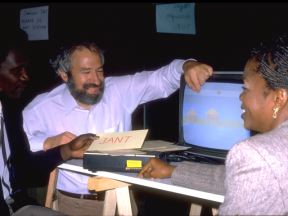
Mme Sylla and M. Niang showing XEW to Seymour Papert
The children of Senegal typically live in a personal, warm family setting
until they are of school age. At home, they live and grow in the culture
of their traditional languages, such as Wolof. At school age, they go off
to a cold and impersonal place where all the language and all the lessons
are French. Some children survive and thrive there, but many are terrified
and refuse to learn. For them, learning in school means alienation from
the people they love, and they reject that alienation even though they are
encouraged to adopt it.
French is the dominant language through which the Senegalese deal with the
exterior world. It is the language of opportunity within the government
and commerce. Further, it is the language which has dominated the schools
and continues to do so. The Senegalese intend to protect and advance their
traditional languages by turning the tide of modern technology to their
own use, specifically by developing literacy in Wolof among their children.
Although Wolof has been written–in an extended Roman alphabet–for more
than a hundred years, only during the last decade has the transcription
of the language become standardized throughout the country. Consequently,
and ironically, many learned people of their land, literate in French and
even Arabic, are illiterate in their traditional language, the language
they use in their homes and in conversation with their African colleagues
at work.
Wanting to change this situation, the Senegalese believe they might better
create programs for computer use in Wolof than in French or in the language
of whoever makes the machines, and they have good reasons. Because there
exists now no rigid "curriculum" for computer education in French,
and because they have not invested years in teacher training in French language
computer instruction, they imagine correctly that this new technology has
a revolutionary potential which can be used to support their traditional
language and culture if they but seize the opportunity.
With others of the Senegal Microcomputer Project, Mamadou Niang and Moussa
Gning came to extend their introduction to Logo in Paris–at the World Center
for Computation and Human Development. Because there is no better way to
learn how to use a computer language than to use it for some significant
purpose, I offered Mamadou this challenge, "You imagine some such microworld
for the children of Senegal, and I will help you make it; let’s work together
to make something your young students will love. "Mamadou noted that,
of course, there are beaches in Senegal and the great city of Dakar, but
that since an objective of their work was to appeal to all the children
of Senegal, it would be more appropriate to think of images of the countryside.
He proposed a village backdrop, with some small buildings and a well. To
enliven such a scene, one would need people and the animals of the country
life, perhaps a cat, horses, cows and so on. We agreed to make only a few
objects, and thereby leave for the children the pleasure of creation; we
would let them decide what they wanted in their world–and provide the tools
for them to make it.
Since we come from cultures so much apart, it is appropriate to comment
on our way of working together. We labored to share ideas. Our working tongue,
our lingua franca, was French; after all, in Paris tout le monde
parle français. . Mamadou and Moussa spoke French much better
than I did. I was grateful that they would tolerate my poor French so that
we could work together. The computer we used was an English language Logo
computer. When they succeeded in helping me understand their objectives,
I would propose and demonstrate programming capabilities and techniques
to embody what Mamadou wanted in the microworld. In a kind of "pidgin"
language, French, English, computerese, they began to program with my guidance
a little scene, some designs of objects to fit in that scene, and some computer
procedures to control their appearance and actions.
When we had created a scene with a number of French language procedure names–
when we had the conceptual objects of this world more or less under control–
we began to discuss using Wolof. This is where Moussa played a most significant
role. As the leading primary-grade pedagogue for Wolof instruction in Senegal,
he was able with confidence to assign definitive spellings to the procedure
names we used to create and manipulate the objects of our village microworld.
(Sometimes this involved consultation with the others of the Senegalese
delegation, including the linguist, Pathe Diagne. )
Because the Logo language permits any string of "keyable" symbols
to be the name of a procedure, we were able to convert French-named procedures
such as"SOLEIL" and "MARCHE" to their Wolof equivalents,
"JANT" and "DOXAL" (the "X" is pronounced
as in Spanish). Thus we arrived at the assembly of procedures and designs
capable of producing the village microworld, "XEW". (The sound
of the name "XEW", meaning "scene", begins with the
Spanish "X" and rhymes with the English "HOW". )
If the village microworld seems bare and crude, there is good reason. It
was not made to impress programmers or civil servants. It is less a product
than a project with a few examples of what is possible. This world is one
to be created by the children of Senegal. Why should I tell them what they
want? Why should even their teachers tell them what creatures and people
to put in the worlds of their imaginations?
It was Mamadou who best expressed the right way of viewing the village microworld.
When I said that the design of "FAS" was incredible, looked ever
so little like a horse, he replied "I’m sure the children will make
a better one. "
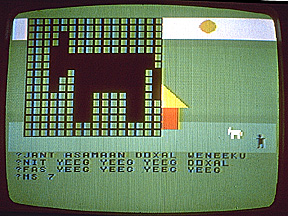
FAS, Mamadou’s Wolof “horse” in the graphics editor
After their introduction to Logo — through the adaptation of ideas for
their country–my colleagues have returned to Senegal to begin a pilot project
with children in the experimental classes of the Ecole Normale Superieure. [3]
The first of the ideas that have been important in progress to this point was
the adoption of Logo as their preferred computer language. Choosing Logo
was important because Logo permits the definition of new computer procedures
and because the language is both powerful and accessible. The second is the
commitment to congeniality, to adapting ideas to maximize their applicability
in terms of their own culture. This is the dimension where accessibility of the
programming language to amateurs is important. Parents, teachers, and older
children may know best what children will accept and understanding and
extending studies now underway at the Ecole Normale Superieure in Dakar.
It also depends on the availability of suitable computer equipment.
Their brave experiment could be one of the most important in the world;
it deserves watching and support.
Publication notes:
- Written in 1983, while “directeur de recherche” at “Le Centre Mondial
pour L’informatique et Ressources Humaine.”
- Published in the UNESCO Courier, (1983, March). This article was written
at the request of the English language editor of the UNESCO Courier, with his
agreement that the 1981 article from the Boston Review could be used as a concrete
example to illustrate a more general hope of ways that computing could aid in education
and development around the world. Published in 26 languages around the world - Photo of Senegalese colleagues and Seymour Papert courtesy of Robert Mohl, Paris.
Text notes:
- Robert LAWLER, of the USA. is a cognitive psychologist and engineer at the “Centre Mondial
lnformatique et Ressources Humaines” (World Centre for Computation and Human Development), Paris.
Mamadou NIANG and Moussa GNING, of Senegal, are teachers at the experimental school of the
Ecole Normale Superieure, Dakar. This article was published in 26 languages, world-wide. - Mindstorms: Children, Computers, and Powerful Ideas, by Seymour Papert. Basic
Books, New York, 1980. - The Senegal Microcomputer Project is supported by the World Centre for
Computation and Human Development, Paris. The participation of Senegal was at
the inspiration of Leopold Senghor and progresses with the continuing support
of Jacques Diouf, Minister of Science and Technology, and Professors Bouna Gaye
and Mohamadou Diallo of the Ecole Normale Superieure. The Logo programming
language was developed by Seymour Papert and colleagues at the Massachusetts
Institute of Technology and around the world.
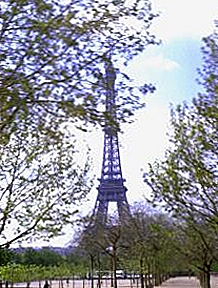 | 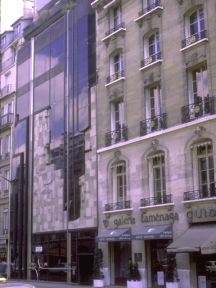 |
|
|
On closing of Le Centre Mondial ten years after its founding, the building shown here passed to other commercial uses.
